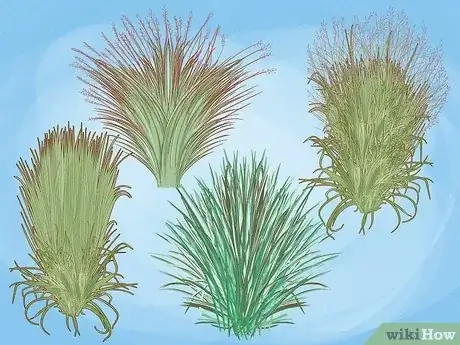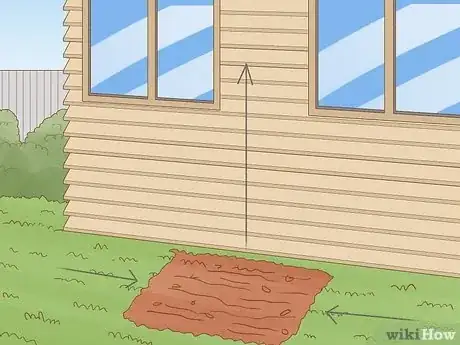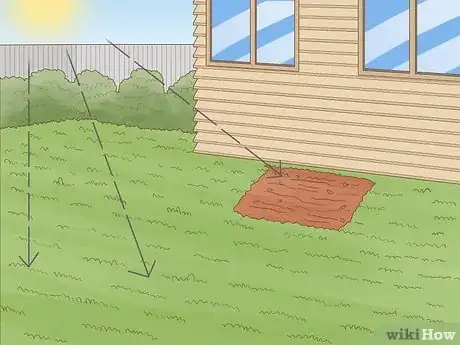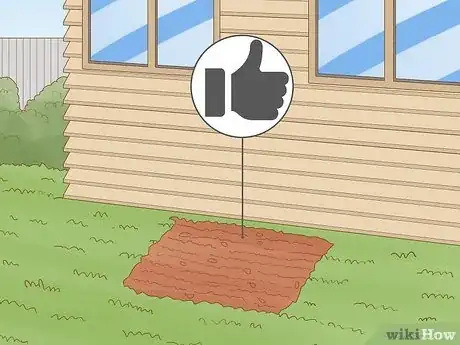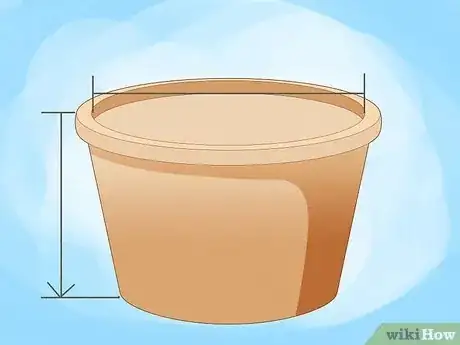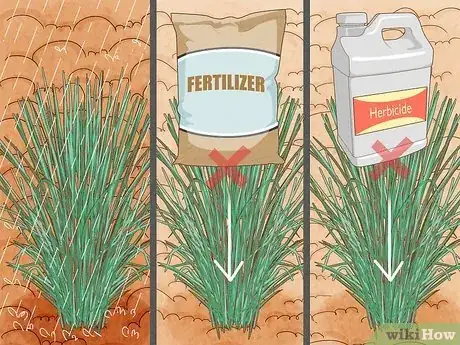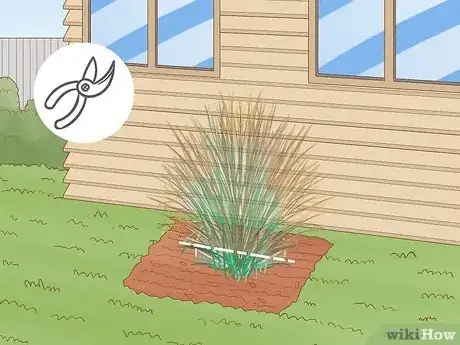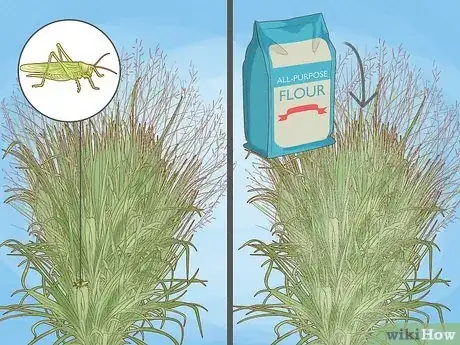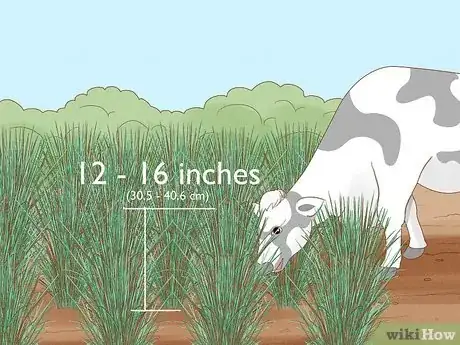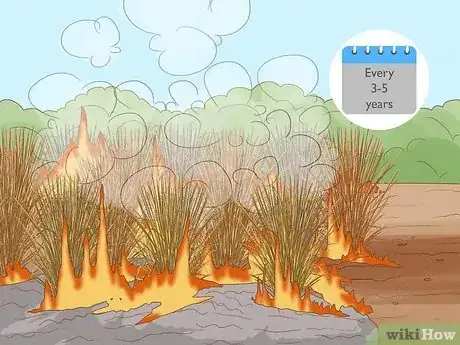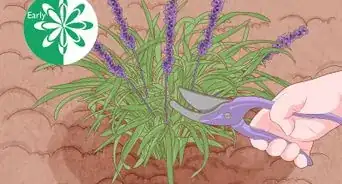This article was co-authored by Katie Gohmann. Katherine Gohmann is a Professional Gardener in Texas. She has been a home gardener and professional gardener since 2008.
There are 11 references cited in this article, which can be found at the bottom of the page.
This article has been viewed 60,252 times.
Native to the United States, switchgrass commonly graces Midwestern prairies and Eastern savannas. Switchgrass can be harvested for use as hay feed or biofuel production, but its height and simple beauty make it a good choice for the home garden as well. Switchgrass roots deeply and can withstand flooding, so it’s a good option if you’re concerned about erosion on your property. Get started by choosing a switchgrass variety that suits your needs, then planting it in a place where it will thrive for years to come.
Steps
Choosing a Variety and Planting Spot
-
1Pick a switchgrass variety. If you look for switchgrass at your local nursery you may just find a plant that's labeled "switchgrass," but there are actually several varieties that differ in color and size. Switchgrass blooms for almost half the year, and during the winter and spring it's usually brown. These are factors to keep in mind when you're choosing a variety for your garden. Here are a few types commonly grown in home gardens:
- Northwind: Grows four to six feet tall and produces yellow blooms.[1]
- Cloud Nine: Grows five to nine feet tall and blooms bright yellow.[2]
- Heavy Metal: Grows four to five feet tall and blooms light pink.[3]
- Shenandoah: Grows just three to four feet tall and blooms rusty pink.[4]
- Rotstrahlbusch: Grows four to five feet tall and produces pink-tinged flowers.[5]
- Warrior: Grows four to six feet tall and blooms green.[6]
-
2Choose a spot that will accommodate its height. Depending on the variety you have, switchgrass can grow anywhere from three to nine feet tall. This is something to take into account when you choosing the right place to plant it. Planting it in the background of the garden, behind smaller plants, will ensure it doesn't obscure the smaller elements in your garden.[7]
- Make sure it has room to grow without blocking windows. Place it strategically so that it falls in between them instead of planting right in front of something you don't want to block.
- While switchgrass gets tall, it won't grow very wide. Don’t worry about spreading; it’s never more than half as wide as it is tall.
Advertisement -
3Look for a sunny spot. Switchgrass is native to prairies and savannas, wide-open spaces with bright, sunny skies. Find a spot in your yard that emulates this natural habitat, a place with plenty of sun and not too many shady trees or buildings that shadow the area for most of the day.
- Too much shade will cause the roots to crawl from side to side, which weakens the switchgrass. In the right conditions, switchgrass roots grow very deep.
- Partial shade is fine if you don't have a completely sunny spot, but full sun is best for thriving switchgrass.
-
4Don’t worry about the soil condition. Switchgrass is a hardy plant that can survive in soil that isn't very rich. Since it’s a native species, it’s quite low maintenance, and there's no need to pre-treat the soil before planting. If you're concerned about your soil quality, check the type of switchgrass you have and look it up to make sure it likes the ground where you live.
- Sandy or loamy soil are both fine for most varieties of switchgrass, so there's no need to treat your soil to change the texture.
- Dry or moist soil are both fine as well, although you wouldn't want the roots to be completely waterlogged.
-
5Consider planting in a container. If you live in one of the few places where switchgrass won’t grow naturally, like the west coast of the US, you can grow it in a pot instead. Choose your switchgrass variety and plant it in standard, untreated potting soil. Make sure the pot you use is sturdy and deep enough to hold the roots without cramping them.[8] The taproot on this plant can grow as deep as 10 feet, so older plants will need exceptionally large pots to keep them healthy.[9]
Planting and Caring for Switchgrass
-
1Plant in early spring. It's the best time to plant switchgrass, since it gives the roots time to get established before the temperature gets too hot. Plant as soon as the soil is workable but before the last frost. The soil temperature should be over 60 degrees when you plant.
- You may need to adjust the planting time to your growing region. If you live in a place where the soil is never far below 60 degrees, planting in fall or winter is fine.
- If you live in a place with harsh, cold winters you may need to wait until late spring to plant your switchgrass.
- Soil is workable with temperature over 60 degrees.
-
2Buy seedlings to plant. Planting seedlings instead of seeds is the easiest way to include ornamental switchgrass in your garden, since seeds are slow to germinate. To plant seedlings,
- Work the soil to a depth of several feet, to accommodate the length of the taproot. Remove obstructions like rocks and other roots.
- Plant the seedlings 12 inches (30.5 cm) apart. Lightly water the area to help the soil settle.
-
3Consider broadcasting switchgrass seeds over lightly worked soil. This is the best method for planting if you want a field of grass, rather than just a plant or two for ornamental purposes. Lightly till the soil to a depth of half an inch using a garden spade or till, then scatter the seeds over the soil. The seeds are slow to germinate.
- If you’d like to try no-till planting, this seed usually does well with that method.
- Water the planting bed immediately after broadcasting the seeds, to help them settle.
- In a garden setting, thin out once the seedlings grow 2 inches (5.1 cm) tall. Leave 12 inches (30.5 cm) of space between them.
-
4Let the sun and rain take care of the switchgrass. After the seedlings are established, there's no need to water them. The switchgrass should get everything it needs from spring and summer rains. Once the root systems are established it will begin gaining height.
- Do not fertilize switchgrass. As a native species, it doesn’t need extra fertilizer to grow healthy. Extra fertilizer can actually damage the plants.
- However, in very poor soil you can fertilize lightly in spring, and in very dry conditions you can water it once in awhile.
- Avoid treating switchgrass with pesticides or herbicides. In the case of ornamental switchgrass, no pests or weeds pose a real threat to this native species.
-
5Shear it back in late winter. Over the summer it will grow quite tall, then dry out and die over the winter. In late winter, shear the switchgrass back to a few inches. The new green grass will begin sprouting as the weather warms and soon reach its adult height again.
Growing Fields of Switchgrass
-
1Watch out for grasshoppers. If you're growing an entire field of switchgrass, the main pest you'll need to worry about is grasshoppers, which are a threat to seedlings when switchgrass is planted at an agricultural scale. If grasshoppers become a concern, there are two main ways you can deal with the problem:[10]
- Dust the switchgrass with flour. Use all-purpose flour and dust the grass and the insects. After two days, rinse it off.
- Treat with chemical pesticides. While strong pesticides are best avoided, especially if you're using switchgrass to feed livestock or house native species, you may have to turn to this option as a last resort.
-
2Harvest after flowering. If you're growing grass to harvest for hay or biofuel, just after flowering is the best time to do it, although you can wait to harvest just after the first frost of the year if you'd like. If you harvest early in the year, you may be able to do a second harvest before winter.[11]
-
3Graze after the switchgrass has reached a height of 12 to 16 inches (30.5 to 40.6 cm). Cattle love to eat switchgrass, so it's a great sustainable food source. Make sure the switchgrass has grow at least a foot high before you graze it, so the plant's roots don't get damaged.
- Stop grazing the area when the grass is six inches off the ground.
- Let it rest for 30 to 60 days before grazing again.
-
4Burn switchgrass fields every three to five years. Burning is a common technique used for different types of native grasses, since it stimulates new healthy growth. It also reduces mulch, which is necessary if you planted the grass to provide shelter for birds and animals that need space among the stalks to thrive.There may be restrictions as to when and how you can burn in your area, so be sure to follow local regulations.[12]
Community Q&A
-
QuestionHow many pounds of seed are needed per acre?
 Katie GohmannKatherine Gohmann is a Professional Gardener in Texas. She has been a home gardener and professional gardener since 2008.
Katie GohmannKatherine Gohmann is a Professional Gardener in Texas. She has been a home gardener and professional gardener since 2008.
Professional Gardener 5 PLS pounds per acre according to http://articles.extension.org/pages/26635/switchgrass-panicum-virgatum-for-biofuel-production
5 PLS pounds per acre according to http://articles.extension.org/pages/26635/switchgrass-panicum-virgatum-for-biofuel-production -
QuestionMy farmer neighbor is planting switch-grass in 2 fields bordering my lawn. Will the grass invade my lawn, or otherwise be a problem for me?
 Community AnswerSwitchgrass is a non-invasive, non-spreading species of ornamental grass. If you Google USDA switchgrass, you can find the USDA release brochure.
Community AnswerSwitchgrass is a non-invasive, non-spreading species of ornamental grass. If you Google USDA switchgrass, you can find the USDA release brochure. -
QuestionHow do I plant penicum grasses? What environment can I plant switchgrass in?
 Community AnswerPanicum grasses are good in a zone 5, 4 and 3 area and maybe a zone 6. They like 4 seasons. They are native to the mid-west of North America and are very beneficial to wildlife such as birds and insects in an urban setting. In the country, grazers utilize this plant as well. It is stunning because it is a warm season grass, you don't see any growth until it starts growing with warmer temperatures. Therefore, it is attractive in a landscape for many seasons. You can leave in your landscape until late winter or early spring of the next year, then cut it back and it starts growing again. Different Panicums have different blooms and shades of colours.
Community AnswerPanicum grasses are good in a zone 5, 4 and 3 area and maybe a zone 6. They like 4 seasons. They are native to the mid-west of North America and are very beneficial to wildlife such as birds and insects in an urban setting. In the country, grazers utilize this plant as well. It is stunning because it is a warm season grass, you don't see any growth until it starts growing with warmer temperatures. Therefore, it is attractive in a landscape for many seasons. You can leave in your landscape until late winter or early spring of the next year, then cut it back and it starts growing again. Different Panicums have different blooms and shades of colours.
References
- ↑ http://www.missouribotanicalgarden.org/PlantFinder/PlantFinderDetails.aspx?kempercode=z240
- ↑ http://www.missouribotanicalgarden.org/PlantFinder/PlantFinderDetails.aspx?kempercode=x740
- ↑ http://www.missouribotanicalgarden.org/PlantFinder/PlantFinderDetails.aspx?kempercode=e460
- ↑ http://www.missouribotanicalgarden.org/PlantFinder/PlantFinderDetails.aspx?kempercode=y310
- ↑ http://www.missouribotanicalgarden.org/PlantFinder/PlantFinderDetails.aspx?kempercode=i580
- ↑ http://www.perennials.com/plants/panicum-virgatum-warrior.html
- ↑ http://www.gardeningknowhow.com/ornamental/foliage/switchgrass/growing-switchgrass.htm
- ↑ http://www.gardeningknowhow.com/ornamental/foliage/switchgrass/growing-switchgrass.htm
- ↑ https://www.gardeningknowhow.com/ornamental/foliage/switchgrass/growing-switchgrass.htm
